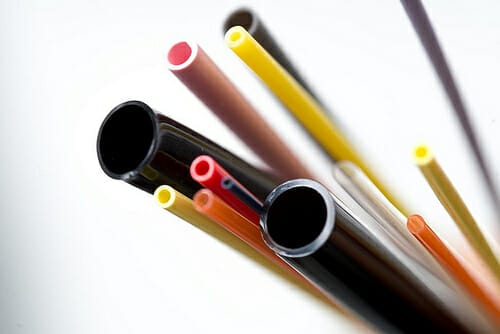
What are thermoplastics?
Thermoplastics cover a wide range of high performance materials from rigid materials such as PEEK and polysulfones to flexible thermoplastic elastomers.
Why would you choose thermoplastic tubing?
Thermoplastic elastomers combine some of the properties of rubber with the processing advantages of thermoplastics. Like rubbers, the thermoplastic elastomers’ key properties are hardness and stiffness or flexibility with the melt processing advantages inherent with thermoplastics.
Thermoplastic urethanes and polyether block amides (PEBA) offer a good balance of tensile strength, toughness, elongation, kink-resistance, hydrolysis-resistance and thermoplastic processability.
What are some options for medical thermoplastics?
At Putnam, our in-house design and manufacturing facilities is capable of extruding virtually all melt-processed thermoplastic resins that can be extruded in natural or compounded forms. Depending on your tubing requirements, color, radiopacity, lubricity and antimicrobial properties can be accommodated.
What other beneficial characteristics does thermoplastic tubing have for medical devices?
Thermoplastic becomes more pliable at warmer temperatures, that, combined with its strength characteristics, thinner walls and larger inner diameter, often make it a better option than silicone for a catheter.
What other options are offered with thermoplastic catheter tubes?
A thermoplastic elastomer coating can be used as a wire coating, ideal for surgical guide wires to increase lubricity and ease of travel through the blood vessels during endovascular procedures.
What medical devices, body parts or procedures is thermoplastic tubing commonly used in?
Thermoplastic urethanes and polyether block amides (PEBA) are perhaps the most commonly used thermoplastic elastomers in applications such as catheter tubing, balloons, wound dressings, surgical drapes, storage bags, strain reliefs and numerous other medical device applications. Thermoplastic polyurethanes dominate the central venous catheter market and are used in some diagnostic and guiding catheter designs. Extruded thermoplastic or thermoset materials are often used in cardiology or interventional radiology. Polyamides (also known as nylons) and polyamide block copolymers (PEBA) dominate the PTCA (percutaneous transluminal coronary angioplasty) catheter market. They are the polymer of choice for balloon catheters and for stent delivery catheters. Medical thermoplastic tubing also serve as drug delivery systems, blood transfusions and intravenous drips (IVs), and cannula for dialysis.
What ISO certification does Putnam Plastics have?
Putnam’s cutting-edge manufacturing facility is ISO 13485:2016 certified. Our ISO compliant clean room meets the demand for greater regulatory controls for thermoplastic extrusion and finishing components.

What are the technical specs?
Thermoplastic Material Property Comparison
| Polymer | Grade (Brand) | Tensile Strength (psi) | Flexural Modulus (psi) | Shore Hardness |
|---|---|---|---|---|
| PEEK | 450G (Victrex®) | 14,500 | 595,000 | |
| Polyimide | 17,100 | 548,000 | ||
| Nylon 11 | BESNO (Rilsan®) | 10,290 | 213,000 | |
| Nylon 12 | L25 (Grilamid®) | 10,150 | 241,000 | 74D |
| AESNO (Rilsan®) | 7,832 | 245,000 | ||
| LF2101F (Vestamid®) | 6,525 | 203,000 | ||
| PEBA | 7233 (Pebax®) | 8,120 | 106,000 | 72D |
| 7033 (Pebax®) | 7,830 | 56,600 | 69D | |
| 6333 (Pebax®) | 7,685 | 42,100 | 63D | |
| 5533 (Pebax®) | 7,540 | 23,200 | 55D | |
| 4033 (Pebax®) | 5,800 | 12,200 | 42D | |
| 3533 (Pebax®) | 5,650 | 3,630 | 33D | |
| 2533 (Pebax®) | 4,640 | 2,180 | 25D | |
| TPU | EG 65D (Tecoflex®) | 8,300 | 2,500 | 60D |
| EG 72D (Tecoflex®) | 8,100 | 3,400 | 67D | |
| EG 93A (Tecoflex®) | 7,700 | 1,100 | 87A | |
| 2363 55D (Pellethane®) | 6,900 | 24,900 | 55D | |
| 2363 65D (Pellethane®) | 6,460 | 32,000 | 65D | |
| 2363 75D (Pellethane®) | 5,810 | 189,000 | 75D | |
| HDPE | LR732 (Petrothene®) | 4,000 | 181,000 | 67D |
| 4903 (Marlex®) | 3,900 | 169,800 |
Why is Putnam the best choice for thermoplastic tubing?
Putnam is a leader in providing quality medical technology solutions and excellent custom manufacturing service for over 40 years.
Find out how our skilled engineering has made us a global supplier for medical tubing by talking with a Putnam representative today.
